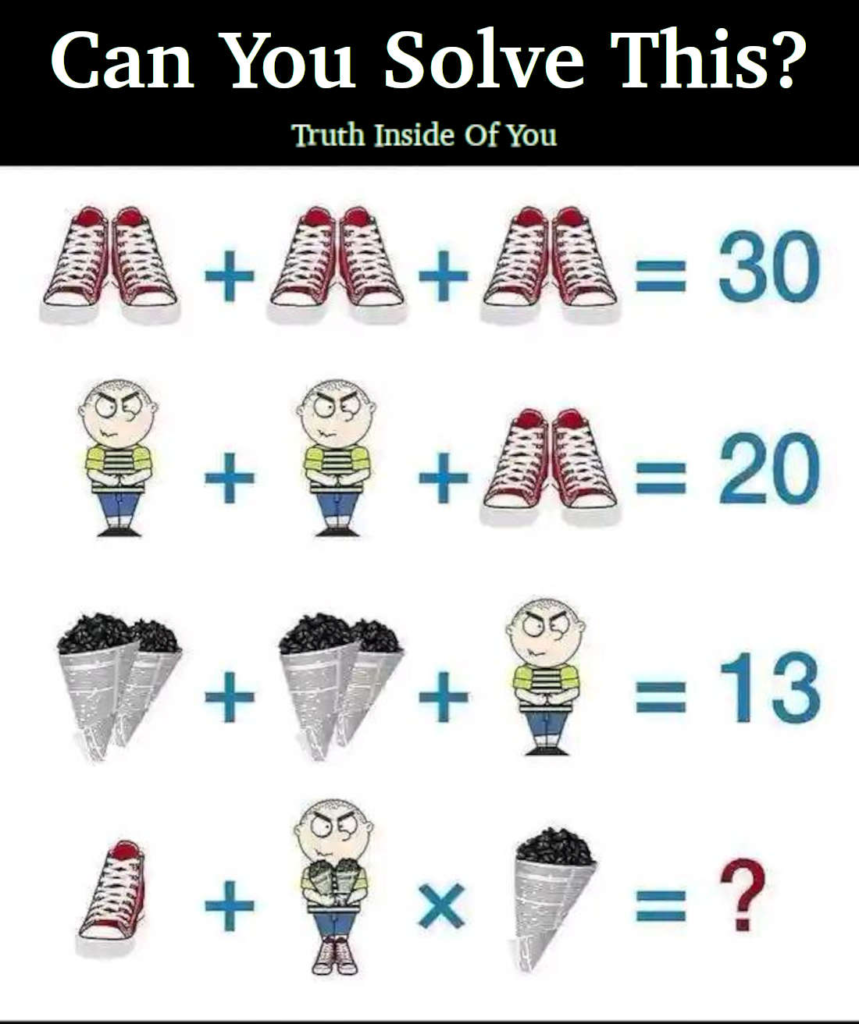

December 7, 2024
This Math Problem Is Leaving The Internet Puzzled. Can You Solve It?
Math problems are a fantastic way to stretch your mind and spark creative thinking. They help improve problem-solving skills while offering a fun challenge. Whether you’re solving riddles with friends or tackling them solo, these puzzles offer entertainment and a mental workout. Here are eight intriguing math problems to test your logic and reasoning skills.
1. The Shoes, Cones, and Boy Puzzle

This classic math puzzle involves a series of equations featuring shoes, cones, and a boy. Each symbol represents a value, and your task is to decode the equations:
- Pair of shoes + Pair of shoes + Pair of shoes = 30
- Boy + Boy + Pair of shoes = 20
- 2 cones + 2 cones + Boy = 13
The final challenge is to solve: Shoe + (Boy + 2 Shoes + 2 Cones) x Cone. Work through the values step by step and see if you arrive at the correct answer: 43.
2. The Closest Time to Midnight

This seemingly simple question asks: What is the closest time to midnight? The options are:
- A: 11:55 PM
- B: 12:06 AM
- C: 11:50 PM
- D: 12:03 AM
The catch lies in understanding “closest to” midnight. The correct answer, based on this phrasing, is A: 11:55 PM, as it approaches midnight from the previous hour. However, many people debate this puzzle, showcasing how interpretation can influence problem-solving.
3. The General Time Question

In another time-related puzzle, the task is to determine the time that is closest from midnight. Given the same options as the previous question, most people agree the answer is D: 12:03 AM, as it is only three minutes past midnight. This puzzle teaches the importance of carefully reading and interpreting questions.
4. The Harvard 1869 Math Exam Challenge

Imagine taking a math exam from 1869 without a calculator. This historical challenge showcases the complexities of solving arithmetic and algebraic equations manually. Try solving this sample problem:
A train travels 60 miles in 2 hours. How long will it take to travel 150 miles at the same speed?
The answer requires simple proportional reasoning: 150÷30=5150 \div 30 = 5 hours. Can you handle other questions like this without modern tools?
5. The Kid’s Clever Crossword Puzzle

In this fun puzzle, a child had to identify three-letter words based on pictures. One clue showed a thumbs-up, leaving the child stumped. The answer? YES. It’s a brilliant example of lateral thinking and the power of simple word associations.
6. The Trick Question

Another “trick” math problem asks: What number comes next in this sequence?
2,4,8,16,?2, 4, 8, 16, ?
At first glance, it appears to follow a pattern of doubling, but the trick lies in breaking expectations. While many might say 32, the actual answer could depend on a hidden rule. Think creatively and explore alternate possibilities.
7. The Missing Coin Puzzle

This riddle asks: Three friends go out to eat and pay $30. Each contributes $10. The waiter gives $5 back. They tip $2 and keep $3. Where is the missing dollar?
The trick lies in understanding there’s no missing dollar. The division of money often confuses people, but clear arithmetic reveals no discrepancy. Puzzles like this sharpen attention to detail.
8. The Famous River Crossing Problem

This puzzle challenges you to get a farmer, a wolf, a goat, and a cabbage across a river. The rules are:
- The boat can only carry two items at a time.
- The wolf cannot be left alone with the goat, and the goat cannot be left alone with the cabbage.
This classic problem requires trial, error, and logical sequencing. The solution involves carefully shuttling items across the river in a specific order.
Math problems challenge our brains to think in unconventional ways. Whether they’re rooted in logic, arithmetic, or lateral thinking, each puzzle offers a unique opportunity to grow and have fun. Try them out and share the joy of solving with friends and family!
Read More: Ever Wondered Why Kate Middleton Always Sits The Same Way?
This content has, in part, been generated with the aid of an artificial intelligence language model. While we strive for accuracy and quality, please note that the information provided may not be entirely error-free or up-to-date. We recommend independently verifying the content and consulting with professionals for specific advice or information. We do not assume any responsibility or liability for the use or interpretation of this content.



